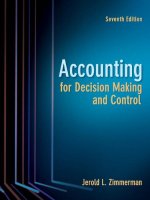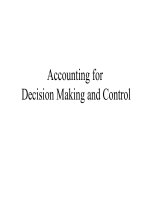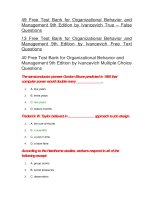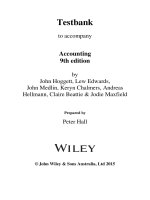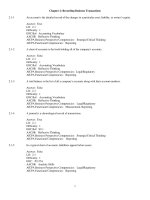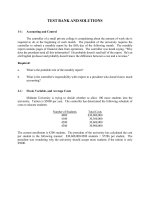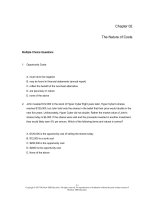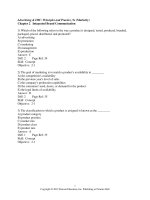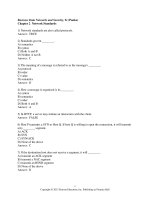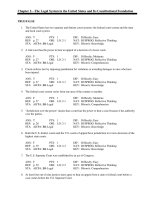Accounting for decision making and control 9th edition zimmerman test bank
Bạn đang xem bản rút gọn của tài liệu. Xem và tải ngay bản đầy đủ của tài liệu tại đây (773.37 KB, 84 trang )
Chapter 02
The Nature of Costs
Multiple Choice Questions
1. Opportunity Costs:
A. must never be negative
B. may be found in financial statements (annual report)
C. reflect the benefit of the next best alternative
D. are pecuniary in nature
E. none of the above
2. John invested $12,000 in the stock of Hyper Cyber Eight years later, Hyper Cyber's shares
reached $125,000, but John held onto the shares in the belief that their price would double in the
next five years. Unfortunately, Hyper Cyber did not double. Rather the market value of John's
shares today is $4,000. If the shares were sold and the proceeds invested in another investment,
they would likely earn 5% per annum. Which of the following terms and values is correct?
A. $125,000 is the opportunity cost of selling the shares today
B. $12,000 is a sunk cost
C. $250,000 is the opportunity cost
D. $2000 is the opportunity cost
E. None of the above
2-1
Copyright © 2017 McGraw-Hill Education. All rights reserved. No reproduction or distribution without the prior written consent of
McGraw-Hill Education.
3. Which of the following can be an opportunity cost?
A. Interest on cost of inventory
B. Cost of idle capacity
C. Cost of underutilized labor
D. The decline in an asset's value
E. All of the above
4. Davos Inc. makes fiberglass ski-boards in Switzerland. Identify the correct matching of terms.
A. Fiberglass is factory overhead
B. Plant real estate taxes are a period cost
C. Depreciation on delivery trucks is a product cost
D. Payroll taxes for workers in the Packaging Department are direct labor
E. None of the above
5. Pamela in Bamplona makes bull-repellent scent according to a traditional Spanish recipe, which
normally sells at €9 (Euros) per unit. Normal production volume is 10,000 ounces per month.
Average cost is €5 per ounce, of which €2 is direct material and €1 is variable conversion cost.
This product is seasonal. After July, demand for this product drops to 6,000 ounces monthly. In
November, Umberto offers to buy 1,500 ounces for €6,000.
If Pamela accepts the order, she must design a special label for Umberto at a cost of €500. Each
label will cost 25 cents to make and apply. Pamela should:
A. accept the order, at a gain of €625
B. reject the order, at a loss of €1,875
C. reject the order, at a loss of €2,375
D. accept the order, at a gain of €1,125
E. none of the above
2-2
Copyright © 2017 McGraw-Hill Education. All rights reserved. No reproduction or distribution without the prior written consent of
McGraw-Hill Education.
6. Pamela in Bamplona makes bull-repellent scent according to a traditional Spanish recipe, which
normally sells at €9 (Euros) per unit. Normal production volume is 10,000 ounces per month.
Average cost is €5 per ounce, of which €2 is direct material and €1 is variable conversion cost.
This product is seasonal. After July, demand for this product drops to 6,000 ounces monthly. In
November, Umberto offers to buy 1,500 ounces for €6,000.
Now assume that the order is received in July, peak season. If Pamela accepts the order, she
will turn away regular customers who order 500 ounces. Pamela should:
A. reject the order, which loses €1,875
B. reject the order as it is less than her cost
C. accept the order if Umberto raises the price higher than €6.58/ounce
D. accept the order if Umberto raises the price higher than €5.58/ounce
E. none of the above
7. Francois French manufactures cheese, which he normally sells at €20/kg, on which sales
commission of 5% is paid. Plant capacity is 7,500 kg/month. Income tax is levied at 30%.
Fixed costs
Costs per kg.
Plant depreciation
€8,000 Direct materials
Other plant costs
15,000 Direct labor
2
Corporate salaries
10,000 Var. factory O/H
3
Advertising
€4
3,000
The number of kilograms to sell to break-even is:
A. 3,273
B. 3,600
C. 3,000
D. 2,300
E. none of the above
2-3
Copyright © 2017 McGraw-Hill Education. All rights reserved. No reproduction or distribution without the prior written consent of
McGraw-Hill Education.
8. Francois French manufactures cheese, which he normally sells at €20/kg, on which sales
commission of 5% is paid. Plant capacity is 7,500 kg/month. Income tax is levied at 30%.
Fixed costs
Costs per kg.
Plant depreciation
€8,000 Direct materials
Other plant costs
15,000 Direct labor
2
Corporate salaries
10,000 Var. factory O/H
3
Advertising
€4
3,000
If sales are 5,000 kgs, which of the following is true?
A. Total contribution margin is €50,000
B. Ratio of total contribution margin to net income before taxes is 3.57
C. Taxes payable are €4,200
D. Operating leverage is 42%
E. All of the above
2-4
Copyright © 2017 McGraw-Hill Education. All rights reserved. No reproduction or distribution without the prior written consent of
McGraw-Hill Education.
9. Francois French manufactures cheese, which he normally sells at €20/kg, on which sales
commission of 5% is paid. Plant capacity is 7,500 kg/month. Income tax is levied at 30%.
Fixed costs
Costs per kg.
Plant depreciation
€8,000 Direct materials
Other plant costs
15,000 Direct labor
2
Corporate salaries
10,000 Var. factory O/H
3
Advertising
€4
3,000
Francois French wants to increase after-tax profits to €35,000. Assuming sufficient demand,
which strategy achieves this goal?
A. Sell 7,100 kgs at the present price
B. Pay the dairy €1/kg less and sell 7,500 kgs
C. Sell 8,000 kgs at €20.79/kg
D. Sell 7,500 kgs at the present price and eliminate the sales commission
E. None of the above
10. The Mojave Water Agency (MWA) sets water policy and water rates for a desert area that faces a
severe water shortage. It has 200,000 customers who are charged $100 per month for the first
20,000 cubic feet (cu.ft) and 1 cent per cu.ft thereafter. The average customer bill is $200 per
month. It costs the agency ¼ cent per cu.ft to monitor and bill for usage. The MWA wants to cut
costs by replacing metered billing with a flat fee which would be added to each property owner's
real estate tax bill. Which is true?
A. The proposed policy will be more expensive to operate and will lead to decreased water usage
B. The proposed policy will be cheaper to operate and will lead to increased water usage
C. The proposed policy will be cheaper to operate and will lead to decreased water usage
D. The most that the MWA should pay the County Real Estate Department for handling the
proposed billing process is $6,000,000
E. b) and d) above
2-5
Copyright © 2017 McGraw-Hill Education. All rights reserved. No reproduction or distribution without the prior written consent of
McGraw-Hill Education.
11. Hardley sells mamburgers. He faces fixed costs of $18,000 per month and variable production
and marketing costs of $2 per mamburger. Market research has developed the following demand
schedule. Which price/volume combination should Yardley choose?
A. Price: $12; Quantity: 4,000
B. Price: $10; Quantity: 5,500
C. Price: $8; Quantity: 7,000
D. Price: $6; Quantity: 9,000
E. Unable to determine
12. Bertie's Burritos, a fast food enterprise, wants to understand his cost structure. He collected data,
which appears below, to analyze costs using the high-low method.
Month
Volume
Total costs
January
5,000
$2,700
February
7,000
$3,700
March
6,000
$3,400
Which is true?
A. Estimated variable costs are 70 cents per burrito
B. Fixed costs cannot be estimated
C. Estimated fixed costs are $200
D. Total costs at volume of 8,000 are estimated at $4,200
E. c) and d) only
Essay Questions
2-6
Copyright © 2017 McGraw-Hill Education. All rights reserved. No reproduction or distribution without the prior written consent of
McGraw-Hill Education.
13. Fixed, Variable, and Average Costs
Midstate University is trying to decide whether to allow 100 more students into the university.
Tuition is $5,000 per year. The controller has determined the following schedule of costs to
educate students:
Number of Students
Total Costs
4,000
$30,000,000
4,100
30,300,000
4,200
30,600,000
4,300
30,900,000
The current enrollment is 4,200 students. The president of the university has calculated the cost
per student in the following manner: $30,600,000/4,200 students = $7286 per student. The
president was wondering why the university should accept more students if the tuition is only
$5,000.
Required:
a. What is wrong with the president's calculation?
b. What are the fixed and variable costs of operating the university?
2-7
Copyright © 2017 McGraw-Hill Education. All rights reserved. No reproduction or distribution without the prior written consent of
McGraw-Hill Education.
14. The Elements of Cost Volume Profit
The M Company's variable costs are 75% of the sales price per unit and their fixed costs are
$240,000. If the company earned $60,000 before taxes in selling 150,000 units, what was the
sales price per unit?
15. Opportunity Costs
The First Church has been asked to operate a homeless shelter in part of the church. To operate
a homeless shelter the church must hire a full time employee for $1,200/month to manage the
shelter. In addition, the church would have to purchase $400 of supplies/month for the people
using the shelter. The space that would be used by the shelter is rented for wedding parties. The
church averages about 5 wedding parties a month that pay rent of $200 per party. Utilities are
normally $1,000 per month. With the homeless shelter, the utilities will increase to $1,300 per
month.
What is the opportunity cost to the church of operating a homeless shelter in the church?
2-8
Copyright © 2017 McGraw-Hill Education. All rights reserved. No reproduction or distribution without the prior written consent of
McGraw-Hill Education.
16. Fixed and Variable Costs:
The university athletic department has been asked to host a professional basketball game at the
campus sports center. The athletic director must estimate the opportunity cost of holding the
event at the sports center. The only other event scheduled for the sports center that evening is a
fencing match that would not have generated any additional costs or revenues. The fencing
match can be held at the local high school, but the rental cost of the high school gym would be
$200. The athletic director estimates that the professional basketball game will require 20 hours
of labor to prepare the building. Clean-up depends on the number of spectators. The athletic
director estimates the time of clean-up to be 2 minutes per spectator. The labor would be hired
especially for the basketball game and would cost $16 per hour. Utilities will be $500 greater if the
basketball game is held at the sports center. All other costs would be covered by the professional
basketball team.
Required:
a. What is the variable cost of having one more spectator?
b. What is the opportunity cost of allowing the professional basketball team to use the sports
center if 10,000 spectators are expected?
c. What is the opportunity cost of allowing the professional basketball team to use the sports
center if 12,000 spectators are expected?
2-9
Copyright © 2017 McGraw-Hill Education. All rights reserved. No reproduction or distribution without the prior written consent of
McGraw-Hill Education.
17. Opportunity Cost of Attracting Industry
The Itagi Computer Company from Japan is looking to build a factory for making Wi-Fi routers in
the United States. The company is concerned about the safety and well-being of its employees
and wants to locate in a community with good schools. The company also wants the factory to be
profitable and is looking for subsidies from potential communities. Encouraging new business to
create jobs for citizens is important for communities, especially communities with high
unemployment.
Wellville has not been very well since the shoe factory left town. The city officials have been
working on a deal with Itagi to get the company to locate in Wellville. Itagi officials have identified
a 20 acre undeveloped site. The city has tentatively agreed to buy the site for $50,000 for Itagi
and not require any payment of property taxes on the factory by Itagi for the first five years of
operation. The property tax deal will save Itagi $3,000,000 in taxes over the five years. This deal
was leaked to the local newspaper. The headlines the next day were: "Wellville Gives Away
$3,000,000 + to Japanese Company".
Required:
a. Do the headlines accurately describe the deal with Itagi?
b. What are the relevant costs and benefits to the citizens of Wellville of making this deal?
2-10
Copyright © 2017 McGraw-Hill Education. All rights reserved. No reproduction or distribution without the prior written consent of
McGraw-Hill Education.
18. Cost, Volume, Profit Analysis
With the possibility of the US Congress relaxing timber cutting restrictions, a local lumber
company is considering an expansion of its facilities. The company believes it can sell lumber for
$0.18/board foot. A board foot is a measure of lumber. The tax rate for the company is 30
percent. The company has the following two opportunities:
• Build Factory A with annual fixed costs of $20 million and variable costs of $0.10/board foot.
This factory has an annual capacity of 500 million board feet.
• Build Factory B with annual fixed costs of $10 million and variable costs of $0.12/board foot.
This factory has an annual capacity of 300 million board feet.
Required:
a. What is the break-even point in board feet for Factory A?
b. If the company wants to generate an after tax profit of $2 million with Factory B, how many
board feet would the company have to process and sell?
c. If demand for lumber is uncertain, which factory is riskier?
d. At what level of board feet would the after-tax profit of the two factories be the same?
2-11
Copyright © 2017 McGraw-Hill Education. All rights reserved. No reproduction or distribution without the prior written consent of
McGraw-Hill Education.
19. Cost, Volume, Profit Analysis
Leslie Mittelberg is considering the wholesaling of a leather handbag from Kenya. She must
travel to Kenya to check on quality and transportation. The trip will cost $3,000. The cost of the
handbag is $10 and shipping to the United States can occur through the postal system for $2 per
handbag or through a freight company which will ship a container that can hold up to a 1,000
handbags at a cost of $1,000. The freight company will charge $1,000 even if less than 1,000
handbags are shipped. Leslie will try to sell the handbags to retailers for $20. Assume there are
no other costs and benefits.
Required:
a. What is the break-even point shipping through the postal system?
b. How many units must be sold if Leslie uses the freight company and she wants to have a profit
of $1,000?
c. At what output level would the two shipping methods yield the same profit?
d. Suppose a large discount store asks to buy an additional 1,000 handbags beyond normal
sales. Which shipping method should be used and what is the minimum sales price Leslie should
consider in selling those 1,000 handbags?
2-12
Copyright © 2017 McGraw-Hill Education. All rights reserved. No reproduction or distribution without the prior written consent of
McGraw-Hill Education.
20. Multiple Product Cost Volume Profit
A company sells three products as shown below:
Product
X
Units
Sales
Variable
Costs
Contribution
Margin
Fixed Costs
Product Product
Y
60,000 140,000
Z
Total
50,000 250,000
$90,000 $150,000 $60,000 $300,000
$63,000 $93,000 $19,000 $175,000
$125,000
$100,000
These three products all always sold in fixed proportions. In other words, Product X always
accounts for 24% of total sales (60,000/250,000), Product Y always accounts for 56% of total
sales (140,000/250,000), and Product Z always accounts for 20% of total sales (50,000/250,000).
Required:
a. How many units of each product need to be sold to break-even?
b. How many units must of each product must be sold if the company wants to have a profit of
$50,000?
2-13
Copyright © 2017 McGraw-Hill Education. All rights reserved. No reproduction or distribution without the prior written consent of
McGraw-Hill Education.
21. Make or Buy
A company needs 10,000 units of a component used in producing one of its products. The latest
internal accounting reports show that the per unit manufacturing cost to be $150.00, variable
manufacturing costs of $110.00 and fixed manufacturing cost of $40. The company recently
received an offer from another manufacturer to produce the component for $144.00. If it buys the
component on the outside 40% of the fixed manufacturing cost can be avoided.
Required:
a. If the company buys the component from the outside supplier at $144.00, what is the impact
on income?
b. What price would make the company indifferent between making the component internally and
having the outside supplier make it?
2-14
Copyright © 2017 McGraw-Hill Education. All rights reserved. No reproduction or distribution without the prior written consent of
McGraw-Hill Education.
22. Cost, Volume, Profit Analysis
Easy Go Company manufactures a line of electric garden tools that are sold in general hardware
stores. The company's controller, Amy Tait, has just received the sales forecast for the coming
year for Easy Go's three products: weeders, hedge clippers, and leaf blowers. Easy Go has
experienced considerable variations in sales volumes and variable costs over the past two years,
and Harlow believes the forecast should be carefully evaluated from a cost-volume-profit
viewpoint. The preliminary budget information for the next year is presented below.
Weeders
Hedge
Leaf
Clippers Blowers
Unit sales
50,000
50,000 100,000
Unit selling price
$28.00
$36.00 $48.00
Variable
manufacturing cost
13.00
12.00
25.00
5.00
4.00
6.00
per unit
Variable selling cost
per unit
For the next year, Easy Go's fixed factory overhead is budgeted at $2 million, and the company's
fixed selling and administrative expenses are forecast to be $600,000. Easy Go has a tax rate of
40 percent.
Required:
a. Determine Easy Go Co.'s budgeted net income for next year.
b. Assuming that the sales mix remains as budgeted, determine how many units of each product
Easy Go must sell in order to break even next year.
c. Determine the total dollar sales Easy Go must sell next year in order to earn an after-tax net
income of $450,000.
d. After preparing the original estimates, Easy Go determines that its variable manufacturing cost
of leaf blowers will increase 20 percent and the variable selling cost of hedge clippers can be
expected to increase $1 per unit. However, Easy Go has decided not to change the selling price
of either product. In addition, Easy Go learns that its leaf blower is perceived as the best value on
the market, and it can expect to sell three times as many leaf blowers as any other product.
Under these circumstances, determine how many units of each product Easy Go will have to sell
to break even in next year.
e. Explain the limitations of cost-volume-profit analysis that Amy Tait should consider when
2-15
Copyright © 2017 McGraw-Hill Education. All rights reserved. No reproduction or distribution without the prior written consent of
McGraw-Hill Education.
evaluating Easy Go's next year's budget.
23. Break-even and Cost-Volume-Profit with Taxes
DisKing Company sells used DVDs on line. The projected after-tax net income for the current
year is $120,000 based on a sales volume of 200,000 DVDs. DisKing has been selling the disks
at $16 each. The variable costs consist of the $10 unit purchase price of the disks and a handling
cost of $2 per disk. DisKing's annual fixed costs are $600,000 and DisKing is subject to a 40
percent income tax rate.
Required:
a. Calculate DisKing Company's break-even point for the current year in number of DVDs.
b. Calculate the increased after-tax income for the current year if projected unit sales volume
increase 10 percent.
c. Management expects that the price DisKing pays for used DVDs to increase 30 percent next
year. If the unit selling price remains at $16, calculate the volume of sales in dollars that DisKing
Company must achieve in the coming year to maintain the same after-tax net income as
projected for the current year.
2-16
Copyright © 2017 McGraw-Hill Education. All rights reserved. No reproduction or distribution without the prior written consent of
McGraw-Hill Education.
24. Cost-Volume-Profit of a Make/Buy Decision
Telly Industries is a multiproduct company that currently manufactures 30,000 units of Part MR24
each month. The facilities now being used to produce Part MR24 have a fixed monthly cost of
$150,000 and a capacity to produce 84,000 units per month. If Telly were to buy Part MR24 from
an outside supplier, the facilities would be idle, but its fixed costs would continue at 40 percent of
its present amount. The variable production costs of Part MR24 are $11 per unit.
Required:
a. If Telly Industries continues to use 30,000 units of Part MR24 each month, it would realize a
net benefit by purchasing Part MR24 from an outside supplier only if the supplier's unit price is
less than how much?
b. If Telly Industries can obtain Part MR24 from an outside supplier at a unit purchase price of
$12.875, what is the monthly usage at which it will be indifferent between purchasing and making
Part MR24?
2-17
Copyright © 2017 McGraw-Hill Education. All rights reserved. No reproduction or distribution without the prior written consent of
McGraw-Hill Education.
25. Opportunity Cost of Purchase Discounts and Lost Sales
Spring Company manufactures hard drives for computer manufacturers. At the beginning of this
year Spring began shipping a much-improved hard drive, Model W899. The W899 was an
immediate success and accounted for $5 million in revenues for Spring this year.
While the W899 was in the development stage, Spring planned to price it at $130. In preliminary
discussions with customers about the W899 design, no resistance was detected to suggestions
that the price might be $130. The $130 price was considerably higher than the estimated variable
cost of $70 per unit to produce the W899, and it would provide Spring with ample profits.
Shortly before setting the price of the W899, Spring discovered that a competitor had a product
very similar to the W899 and was no more than 60 days behind Spring's own schedule. No
information could be obtained on the competitor's planned price, although it had a reputation for
aggressive pricing. Worried about the competitor, and unsure of the market size, Spring lowered
the price of the W899 to $100. It maintained the price although, to Spring's surprise, the
competitor announced a price of $130 for its product.
After reviewing the current year's sales of the W899, Spring's management concluded that unit
sales would have been the same if the product had been marketed at the original price of $130
each. Management has predicted that next year's sales of the W899 would be either 85,000 units
at $100 each or 60,000 units at $130 each. Spring has decided to raise the price of the disk drive
to $130 effective immediately.
Having supported the higher price from the beginning, Sharon Haley, Spring's marketing director,
believes that the opportunity cost of selling the W899 for $100 should be reflected in the
company's internal records and reports. In support of her recommendation, Haley explained that
the company has booked these types of costs on other occasions when purchase discounts not
taken for early payment have been recorded.
Required:
a. Define opportunity cost and explain why opportunity costs are not usually recorded.
b. What is the current year's opportunity cost?
c. Explain the impact of Spring Company's selection of the $130 selling price for the W899 on
next year's operating income. Support your answer with appropriate calculations.
2-18
Copyright © 2017 McGraw-Hill Education. All rights reserved. No reproduction or distribution without the prior written consent of
McGraw-Hill Education.
26. Make/Buy and the Opportunity Cost of Freed Capacity
Zelean Manufacturing uses 10 units of part KJ37 each month in the production of radar
equipment. The cost to manufacture one unit of KJ37 is presented in the accompanying table.
Direct materials
Materials handling (20% of direct material
cost)
Direct labor
$1,000
200
8,000
Manufacturing overhead
12,000
Total manufacturing cost
$21,200
Materials handling represents the direct variable costs of the receiving department and is applied
to direct materials and purchased components on the basis of their cost. This is a separate
charge in addition to manufacturing overhead. Zelean's annual manufacturing overhead budget is
one-third variable and two-third fixed. Scott Supply, one of Zelean's reliable vendors, has offered
to supply part KJ37 at a unit price of $15,000. The fixed cost of producing KJ37 is the cost of a
special piece of testing equipment that ensures the quality of each part manufactured. This
testing equipment is under a long-term, noncancelable lease. If Zelean were to purchase part
KJ37, materials handling costs would not be incurred.
Required:
a. If Zelean purchases the KJ37 units from Scott, the capacity Zelean was using to manufacture
these parts would be idle. Should Zelean purchase the parts from Scott? Make explicit any key
assumptions.
b. Assume Zelean Manufacturing is able to rent all idle capacity for $25,000 per month. Should
Zelean purchase from Scott Supply? Make explicit any key assumptions.
c. Assume that Zelean Manufacturing does not wish to commit to a rental agreement but could
use idle capacity to manufacture another product that would contribute $52,000 per month.
Should Zelean manufacture KJ37? Make explicit any key assumptions.
2-19
Copyright © 2017 McGraw-Hill Education. All rights reserved. No reproduction or distribution without the prior written consent of
McGraw-Hill Education.
27. "Price gouging" or increased opportunity cost?
After the Iraqi invasion of Kuwait in August 1990, the world price of crude oil doubled to more
than $30 per barrel in anticipation of reduced supply. Immediately, the oil companies raised the
retail price on refined oil products even though these products were produced from oil purchased
at the earlier, lower prices. The media charged the oil companies with profiteering and price
gouging, and politicians promised immediate investigations.
Required:
Critically evaluate the charge that the oil companies profited from the Iraqi invasion. What advice
would you offer the oil companies?
2-20
Copyright © 2017 McGraw-Hill Education. All rights reserved. No reproduction or distribution without the prior written consent of
McGraw-Hill Education.
28. Break-even analysis with multiple products
You are a new consultant with the Boston Group and have been sent to advise the executives of
Penury Company. The company recently acquired product line L from an out-of-state concern
and now plans to produce it, along with its old standby K, under one roof in a newly renovated
facility. Management is quite proud of the acquisition, contending that the larger size and related
cost savings will make the company far more profitable. The planned results of a month's
operations, based on management's best estimates of the maximum product demanded at
today's selling prices are:
LINE K
Amount
Sales
revenue
Variable
expense
Contribution
margin
LINE L
Per
Unit
Amount
Per
Unit
Total
$120,000 $1.20 $80,000 $0.80 $200,000
60,000 0.60 60,000 0.60 120,000
$60,000 $0.60 $20,000 0.20
Fixed
expense
Net income
80,000
50,000
$30,000
Required:
a. Based on historical operations, K alone incurred fixed expenses of $40,000, and L alone
incurred fixed expenses of $20,000. Find the break-even point in sales dollars and units for each
product separately.
b. Give reasons why the fixed costs for the two products combined are expected to be less than
the sum of the fixed costs of each product line operating as a separate business.
c. Assuming that for each unit of K sold, one unit of L is sold, find the break-even point in sales
dollars and units for each product.
2-21
Copyright © 2017 McGraw-Hill Education. All rights reserved. No reproduction or distribution without the prior written consent of
McGraw-Hill Education.
29. Average versus Variable Cost
Measer Enterprises produces energy-efficient light bulbs and operates in a highly competitive
market in which the bulbs are sold for $4.50 each. Because of the nature of the production
technology, the firm can produce only between 10,000 and 13,000 units per month, in fixed
increments of 1,000 units. Measer has the following cost structure:
Production and Cost Data
Units Produced
10,000 11,000 12,000 13,000
Factory cost,
variable
Factory cost,
fixed
Selling cost,
variable
Administration,
fixed
Total
Average unit
cost
$37,000 $40,800 $44,600 $48,400
9,000
9,000
9,000
9,000
6,000
6,600
7,400
8,200
6,000
6,000
6,000
6,000
$58,000 $62,400 $67,000 $71,600
$5.80
$5.67
$5.58
$5.51
Required:
At what output level should the firm operate?
2-22
Copyright © 2017 McGraw-Hill Education. All rights reserved. No reproduction or distribution without the prior written consent of
McGraw-Hill Education.
30. Break-even Analysis
The MedView brochure said, "Only 45 scans per month to cover the monthly equipment rental of
$18,000." The footnote at the bottom of the brochure read: *"Assumes a reimbursable fee of $475
per scan."
The MedView brochure refers to a new radiology imaging system that MedView rents for
$18,000 per month. A "scan" refers to one imaging session that is billed at $475 per scan. Each
scan involves giving the patient a chemical injection and requires exposing and developing an Xray negative.
Required:
a. What variable cost per scan is MedView assuming in calculating the 45-scans-per-month
amount?
b. Is the MedView brochure really telling the whole financial picture? What is it omitting?
2-23
Copyright © 2017 McGraw-Hill Education. All rights reserved. No reproduction or distribution without the prior written consent of
McGraw-Hill Education.
31. Break-even Analysis
Exotic Roses, owned by Margarita Rameriz, provides a variety of rare rose bushes to local
nurseries that sell Rameriz's roses to the end consumer (landscapers and retail customers).
Rameriz grows the roses from cuttings that she has specifically cultivated for their unusual
characteristics (color, size, heartiness, and resistance to disease). Margarita's roses are in great
demand as evidenced by the wholesale price she charges nurseries, $15 per potted plant. Exotic
Roses has the following cost structure (variable costs are per potted plant):
Fixed Costs per Year Variable Costs
Plant materials
$0.50
Pot
0.30
Labor
$8,000
Utilities
9,000
Rent
7,500
Other costs
2,500
0.70
Required:
a. How many potted rose plants must Exotic Roses sell each year to break even?
b. If Rameriz wants to make profits of $10,000 before taxes per year, how many potted rose
plants must be sold?
c. If Rameriz wants to make profits of $10,000 after taxes per year, how many potted rose plants
must be sold assuming a 35 percent income tax rate?
2-24
Copyright © 2017 McGraw-Hill Education. All rights reserved. No reproduction or distribution without the prior written consent of
McGraw-Hill Education.
32. Break-even Analysis
You are evaluating ways to expand an optometry practice and its earnings capacity.
Optometrists perform eye exams, prescribe corrective lenses (eyeglasses and contact lenses),
and sell corrective lenses. One way to expand the practice is to hire an additional optometrist.
The annual cost of the optometrist, including salary, benefits, and payroll taxes, is $63,000. You
estimate that this individual can conduct two exams per hour at an average price to the patient of
$45 per exam. The new optometrist will work 40-hour weeks for 48 weeks per year. However,
because of scheduling conflicts, patient no-shows, training, and other downtime, the new
optometrist will not be able to conduct, bill, and collect 100 percent of his or her available
examination time.
From past experience, you know that each eye exam drives additional product sales. Each exam
will lead to either an eyeglass sale with a net profit (revenue less cost of sales) of $90 (not
including the exam fee) or a contact lens sale with net profits of $65 (not including the exam fee).
On average, 60 percent of the exams lead to eyeglass sales, 20 percent lead to contact lens
sales, and 20 percent of the exams lead to no further sales.
Besides the salary of the optometrist, additional costs to support the new optometrist include:
Office occupancy costs
Leased equipment
Office staff
$1,200/year
$330/year
$23,000/year
Required:
In terms of the percentage of available time, what is the minimum level of examinations the new
optometrist must perform to recover all the incremental costs of being hired?
2-25
Copyright © 2017 McGraw-Hill Education. All rights reserved. No reproduction or distribution without the prior written consent of
McGraw-Hill Education.
